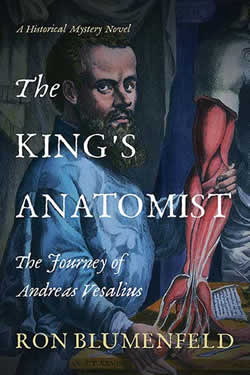The King's Anatomist - Book Cover
Click on the image for a larger version
[UPDATED 11/30/2023] “In 1565 Brussels, the reclusive mathematician Jan van den Bossche receives shattering news that his lifelong friend, the renowned and controversial anatomist Andreas Vesalius, has died on the Greek island of Zante (today’s Zakynthos) returning from a pilgrimage to the Holy Land. Jan decides to journey to his friend’s grave to offer his last goodbye…” Thus begins the saga and the book the “King’s Anatomist”.
In June 2022 during the annual American Association of Clinical Anatomists (AACA) meeting in Fort Worth, TX, I was lucky to bid and win this, one of the latest books on Andreas Vesalius. This book, written by Ron Blumenfeld, MD. proved to be not only a great read, but also an quite historically accurate story. Let me explain this statement.
The book belongs to the genre of Historical Fiction, where the author does detailed research on a topic and then writes on accurate background but adds fictional characters and situations. Sometimes, as in this book, it follows a mystery that slowly unravels leading to shocking situations. To be fair, the author does explain what is not necessarily quite historically accurate, so as to leave no doubt about what is real or not.
The book is enthralling, the plot well developed, and the description of the academic environment, the details of the scenery for the travelers, the pettiness of war, etc., is not only interesting, but also portrays the times during the life of Andreas Vesalius in such a way that I felt transported there. It was very difficult to put the book down until I finished it.
The author does a great job getting us a little bit closer to who was Andreas Vesalius, the child at school, the youngster, the anatomist, the friend, the father, and the husband.
I should probably stop here and let you decide on the book for yourself without giving too much away. I strongly recommend this book and hope that you will enjoy it as much as I did. You can visit Ron’s website here to buy his book.
Ron and I both attended the 2014 “Vesalius Continuum” meeting in the Greek island of Zakynthos. This meeting celebrated the 500th anniversary of the birth of Andreas Vesalius. Part of the book he wrote is based on the discussions and presentations at this meeting.
Ron Blumenfeld
Following are some excerpts of Ron’s bio and website in his own words:
“I’m a native New Yorker, pediatrician and health care executive who reunited with his inner writer in retirement. I surrendered the pleasure of writing columns on various topics for my local newspaper in Connecticut to focus on my debut novel, The King’s Anatomist”
“There always was a writer cooped up inside me, but he got loose only after I retired. I had permitted him to show up only in school classes, health and business writing, and newspaper columns, but I realize now that I kept him on a short leash because I was afraid of him – afraid of his disruptive potential and afraid of what he would look like to the world. But at this point in my life, I got past those excuses and let him out to see what he could do.
"The King’s Anatomist, it turned out, was an ideal writing project, anchored in facts, but with ample room for creativity. Thank you, Andreas Vesalius, for being such an interesting guy.”
UPDATE: I was glad to see Ron Blumenfeld again when he attended the 2023 Vesalius Triennial Meeting in the city of Antwerp, Belgium where I had been invited to participate. We had a great time in the conference, walking around the city, and at local restaurants! Also, thank you, Ron, for signing and dedicating my personal copy of your book. It has a nice place in my library. Dr. Miranda.
Should you want to look for more information on Andreas Vesalius in this website click here.




